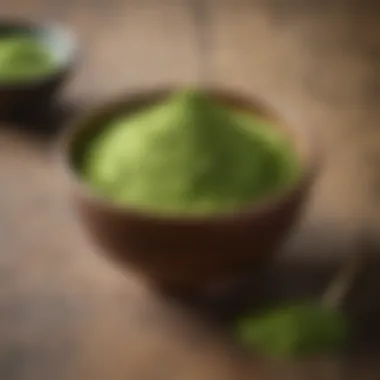Understanding Matcha Powder: Quantity, Quality, Usage


Intro
Matcha powder has gained popularity in recent years, not only for its vibrant color and unique flavor but also for its numerous health benefits. As a powdered form of green tea, matcha boasts a rich history in Japanese culture, where it has traditionally been associated with tea ceremonies. Understanding the proper quantities, quality, and versatile uses of matcha is key for both seasoned chefs and home cooks looking to elevate their culinary creations.
In this article, we will dive into essential aspects of matcha powder, giving clarity on its various applications in cooking and beverages. We aim to educate readers about the best practices when it comes to selecting high-quality matcha, its optimal usage in various dishes, and practical tips for storage to preserve its unique properties.
Ingredients Breakdown
When incorporating matcha into your kitchen repertoire, understanding the key ingredients and tools is critical. This section breaks down these essentials.
Primary Ingredients
Matcha powder is typically made using finely ground shade-grown tea leaves. The choice of matcha can significantly impact the flavor and overall sensory experience of dishes. Look for high-grade culinary matcha, which is usually bright green in color and has a fine texture.
Optional Ingredients
While matcha can stand alone, it often pairs well with several optional ingredients:
- Sweeteners (like honey or agave syrup)
- Dairy or non-dairy milk (almond or oat milk are great choices)
- Vanilla extract for flavor
- Spices like cinnamon for variety
Essential Kitchen Tools
Using the right tools can facilitate a seamless preparation process:
- A fine sieve for screening matcha to avoid clumps
- A bowl for whisking
- A bamboo whisk (chasen) to effectively incorporate matcha into liquids
- Storage containers that are opaque, to safeguard the powder from light and moisture.
Step-by-Step Preparation
Proper preparation helps unlock matcha's potential. Follow these guidelines:
Prepping the Ingredients
Begin by measuring out the matcha powder. A common ratio is one to two teaspoons per serving.
Cooking Techniques and Methods
You can integrate matcha using several methods, including:
- Whisking with hot water: The traditional way to enjoy matcha.
- Baking: Add matcha into cookies or cakes for flavor and color.
- Blending in smoothies: A great way to boost nutritional intake.
Assembly and Presentation Tips
When presenting matcha dishes:
- Use small plates or bowls for single servings.
- Garnish with fruits or sprinkles of matcha for visual appeal.
Dietary Considerations
Matcha's versatility makes it suitable for various dietary preferences.
Gluten-Free Options
Most matcha powder is inherently gluten-free. Always check certification to ensure zero cross-contamination.
Vegetarian and Vegan Substitutes
Matcha can easily substitute various ingredients in vegetarian or vegan dishes, such as substituting cow's milk with almond or soy milk.
Nutrition Facts & Nutritional Considerations
Matcha boasts a bounty of nutrients. It contains higher antioxidants compared to regular green tea, which can bolster health.
Variations and Customizations


Customization allows you to explore matcha beyond its classic applications.
Flavor Enhancements
To enrich the taste, try adding:
- Nutmeg or ginger for warmth
- Citrus including lemon zest for a fresh kick
Alternative Cooking Methods
In addition to traditional methods, consider experimenting with unconventional techniques:
- Cold brewing with cold water
- Introducing matcha into sauces or dressings
Pairing Suggestions (Sides, Drinks, etc.
)
Successful pairings can amplify flavors:
- Pair matcha with Asian-inspired dishes like sushi.
- Enhance drinks like lemonade or extended caffeinated beverages such as lattes.
Common Common Questionss and Troubleshooting
Addressing common queries and issues can improve your matcha experience.
Frequently Asked Questions
Is matcha different from regular green tea? Yes, matcha involves consuming the whole leaf in powdered form.
Common Mistakes to Avoid
- Overheating water: Stick to water around 175°F to avoid bitterness.
- Using poor-quality matcha: It will result in undesirable flavors.
Solutions to Potential Problems
If matcha clumps together, ensure to use a fine sifter or re-whisk to smoothen the texture.
Matcha powder integrates not only vibrant color but also a wealth of nutrients, making it a powerful addition in your kitchen.
Prelims to Matcha Powder
Understanding matcha powder goes beyond its culinary application; it encompasses its profound cultural heritage and a growing recognition of its health virtues. As matcha gains popularity across continents, food lovers and health enthusiasts alike seek to appreciate what differentiates it from other types of green tea. This initial section serves as a foundation for exploring matcha, illuminating its unique properties, methods of preparation, and significant benefits. Through a detailed examination of its essence and origins, readers will appreciate the roots of matcha powder in Japanese culture, as well as how it integrates into modern dietary routines.
What Is Matcha Powder?
Matcha is a type of powdered green tea made from shade-grown tea leaves. When processed, the leaves are dehydrated and ground into a fine powder, which dissolves when whisked into hot water. Unlike regular green tea, which involves steeping the leaves, matcha tea preparation involves consuming the whole leaf in powdered form. This method not only makes matcha flavorful but also allows for a higher concentration of nutrients, providing numerous health benefits.
When looking for matcha products, it is critical to identify its quality. Higher grades result in a more vibrant color and a sweeter, milder taste, achieved through careful cultivation and precise mixing techniques. The fresh powder can possess various culinary applications, from simple teas to elaborate desserts.
Origins and Cultural Significance
The origins of matcha date back nearly a millennium to China, but it gained fame within the context of Japanese tea ceremonies. Matcha set itself apart, representing tranquility and mindfulness. The ceremonial practice emphasizes the art of preparing and consuming tea, promoting a peaceful state of mind. Today, it still retains substantial cultural weight within Japan, symbolizing connection, harmony, and respect.
The traditional tea ceremony, known as Chanoyu, highlights the masterly use of matcha. This tea ritual embodies aesthetic values and practices that surround matcha preparation, making it more than merely a beverage but a platform for social interaction and appreciation of nature's beauty. It is essential for modern enthusiasts to connect with this historical mindset, as understanding these cultural nuances enhances their overall matcha experience.
Nutritional Profile of Matcha Powder
Understanding the nutritional profile of matcha powder is essential for grasping its impact on health and dietary choices. Matcha stands out from conventional green tea due to its unique production method and concentrated benefits. By delving into its nutrient composition, individuals can better appreciate why matcha has gained popularity among health-conscious individuals and culinary creators alike.
Key Nutrients in Matcha
Matcha powder is a treasure trove of nutrients that contribute substantially to its health benefits. Key components include:


- Antioxidants: Matcha contains high levels of catechins, going significantly beyond those found in conventional green tea. The most prominent catechin, EGCG (epigallocatechin gallate), is recognized for its potential in reducing the risk of various chronic diseases.
- Amino Acids: This powder is rich in the amino acid L-theanine, known for promoting relaxation while maintaining alertness. It contributes a unique calming balance, an essential aspect for those who seek focused energy without jitters.
- Vitamins and Minerals: Notable vitamins include vitamin C, beta-carotene, vitamin K, and B vitamins. These nutrients are important for immune function and overall health.
- Fiber: Matcha provides a form of dietary fiber that can aid digestion and support gut health.
The combination of these nutrients makes matcha not just a beverage but a whole food that integrates seamlessly into various diets.
Health Benefits Associated with Matcha
Incorporating matcha powder into your diet can yield a multitude of health benefits. Here are some key advantages:
- Weight Management: Studies suggest that matcha may assist in weight loss by enhancing metabolic rate and increasing fat oxidation during exercise.
- Enhanced Focus and Clarity: The L-theanine in matcha helps to improve cognitive function. Many users report heightened awareness and clarity of thought after consuming matcha.
- Immune System Support: Due to its rich antioxidant profile, matcha can bolster the immune system, helping the body defend against illness.
- Heart Health: Regular consumption of matcha has been linked to improved cholesterol levels, thus supporting cardiovascular health.
- Detoxification: Chlorophyll levels in matcha are notably high and are believed to aid the body in detoxification processes by improving liver function and eliminating toxins.
Consistently integrating matcha into your daily routine has the potential to support both mental acuity and physical well-being.
While consuming matcha, it's important to consider overall lifestyle choices, as balance is crucial for achieving optimal health benefits.
How Much Matcha Powder to Use?
Understanding how much matcha powder to incorporate into your diet is essential. This guide provides details on serving sizes relevant to various contexts, from daily intake to culinary applications. Trying to find the right amount can impact flavor and nutrition, which makes this topic critical for food enthusiasts.
Daily Recommended Intake
The daily recommended intake of matcha powder can vary depending on personal preference and other factors. Generally, starting with one to two teaspoons or about 1 to 2 grams per day is a good practice. This quantity strikes a balance between taste and health benefits. Consuming more than this may not be necessary and could lead to potential side effects such as insomnia or jitteriness.
An effective approach to be sure is to pay attention to your body’s responses to matcha. If you feel energized and alert, you may have found your personal sweet spot. However, if you feel uneasy or overly stimulated, it may be beneficial to reduce your intake.
Matcha in Beverages
Tea Preparation
For tea preparation, matcha is whisked with hot water to create a frothy drink. This technique highlights matcha's unique flavor and rich texture. The vibrant green color and smooth consistency make tea preparation a popular choice for matcha enthusiasts. It also ensures most of the health benefits are retained in the beverage, making it an advantageous method for incorporating matcha powder into your day.
However, it is essential to use the right temperature for the water. If the water is too hot, it can make the tea bitter rather than offering that delightful umami flavor. Ensuring correct water temperature can make all the difference.
Smoothies and Lattes
Incorporating matcha into smoothies and lattes can be a delightful and nutritious way to start the day or power up in the afternoon. A key characteristic of smoothies and lattes is their ease of preparation and the ability to combine various ingredients like fruits or milk alternatives. Matcha adds not only a lively green hue but also a nutritional boost when blended with other components.
One disadvantage, though, can be the challenge of maintaining the balance of flavors. It is vital to add the correct amount, or matcha can overpower other ingredients. Starting with half a teaspoon in smoothies can provide subtle notes without dominating the flavor profile. This makes it both a useful and versatile choice for enhancing beverages.
Culinary Uses of Matcha
Baking Applications
Baking with matcha can introduce a unique twist to traditional recipes. Many people quickly associate matcha with sweets, and incorporating it yields visually appealing and flavorful results. Whether it is in matcha cookies, cakes or even macarons, using matcha can impart not just color but also a complex taste to baked goods. Additionally, its natural sweetness means you often can reduce the added sugar in the recipes.
One noteworthy aspect, however,is that matcha can alter the texture of some baked goods. Knowing how it interacts with different types of flour or leavening agents is vital for achieving the desired result. Careful experimentation is the key here.
Cooking and Savory Dishes
Using matcha for cooking in savory dishes is less common but equally fascinating. It can enhance flavor profiles in items like salad dressings or pasta. The slightly earthy and grassy notes of matcha can complement ingredients well. This feature allows incorporating matcha into meals as a part of main courses rather than just desserts and beverages, adding versatility to its usage.
The challenge here lies in balancing brown flavors. Since matcha can be potent, starting with a minimal quantity is important to avoid overshadowing the other flavors. This balance might encourage creative tweaks, making matcha a surprising ingredient in meals.
Selecting Quality Matcha Powder
The selection of high-quality matcha powder is critical for maximizing taste, health benefits, and overall culinary experiences. This topic is inherently important within the broader context of understanding matcha powder. High-quality matcha is favourable not only for its flavour profile but also for its nutritional value. Choosing inferior products can lead to disappointing flavors and less beneficial effects on health. Thus, an informed selection is essential for any food enthusiast who aims to fully appreciate and utilize this ingredient.
Types of Matcha: Ceremonial vs.
Culinary
There are two main types of matcha — ceremonial and culinary. Ceremonial matcha is typically designed for traditional tea ceremonies and is known for its vibrant color and complex flavor. It is ground finely and produced with utmost care, making it suitable for straight consumption. In contrast, culinary matcha is often used in cooking and baking. It may vary more in quality and price. This type can sometimes have a slightly less delicate flavor and might not be as brightly colored.
Understanding these categories is crucial. When aiming for health benefits or rich flavour in tea, ceremonial matcha is usually the preferred choice. However, for smoothies or baked goods, culinary grade can deliver good results without the higher cost.


What to Look for in Quality Matcha
Color and Texture
The color of matcha can be a strong indicator of its quality. High-quality matcha tends to be a bright, vibrant green. This rich color signals a high chlorophyll content, which is often associated with superior nutritional value. Duller, yellowish matcha usually indicates lower quality. The texture also plays a role. Fine, silky powder is favored because it blends seamlessly into beverages and recipes, enhancing the overall texture of the dish or drink. A gritty texture suggests a lack of refinement in the grinding process, potentially leading to unpleasant mouthfeel.
Origin and Production Methods
The origin of matcha is important, as it can impact both the flavor profile and the nutrient composition. Matcha traditionally comes from Japan, where various regions like Uji and Nishio are known for their superior cultivation methods. Knowing where your matcha is produced can guide your purchase decisions. If the powder uses high-quality production methods, it usually passes through careful shading before harvesting, and the leaves are stone-ground into a fine powder.
- The shaded growth technique showcases greater flavonoid levels.
- Traditional methods preserve the nutritional qualities, making these factors beneficial for consumers.
Such flowers will yield a product that energizes while providing protection against oxidative stress.
When choosing matcha, always consider factors like color, texture, origin, and production methods to guarantee quality.
Understanding these characteristics allows consumers to appreciate the distinct nuances of various matcha powders. Overall, higher-quality matcha not only enriches the drinking experience but also heightens the nutritional value enjoyed through consumption.
Storing Matcha Powder Properly
Storing matcha powder properly is essential for preserving its flavor, potency, and nutritional value. Since matcha oxidizes quickly and loses its vibrancy when exposed to light, air, or moisture, knowing how to store it correctly ensures you maintain its fresh character. Let's explore optimal storage conditions and shelf life for matcha powder, crucial elements to consider for aficionado and beginners alike.
Optimal Storage Conditions
Matcha powder should be stored in a way that minimizes its exposure to degrading conditions. The best practices for optimal storage include:
- Airtight Container: Always store matcha powder in an airtight container. This prevents air entry that can cause oxidation, leading to a dull taste and color. A tin is a great option, as it keeps the matcha sealed tight.
- Refrigeration: Though not always mandatory, refrigerating matcha can add an extra layer of protection. When doing so, it is wise to seal it tightly after taking some out, to avoid moisture exposure from the warmer air that can enter.
- Cool, Dark Place: If refrigeration is not suitable, keep matcha in a cool and dark place away from direct sunlight. Locations such as a pantry can be ideal, but ensure the temperatures remain consistent, avoiding hot spots.
By following these basic guidelines, matcha can retain its noteworthy characteristics, vibrant color, and noteworthy benefits.
Shelf Life of Matcha Powder
The shelf life of matcha powder depends largely on its quality and storage conditions. Here’s what to keep in mind:
- Ceremonial Grade: Typically, this higher-grade matcha lasts around 6 to 8 months if stored properly. It's advisable to use this matcha during its prime to enjoy robust flavors.
- Culinary Grade: It tends to have a longer shelf life, up to 12 months due to its processing. However, it also loses its flavor quicker than ceremonial grade.
- Signs of Deterioration: A change in color from vibrant green to dull yellow or brown suggests matcha past its best. Also, if the aroma is weak or unappealing, it might be time to consider buying fresh supply.
To maximize quality, one of the key recommendations is using matcha within six months for best flavor, as freshness plays a significant role in the overall experience. Both expertise in utilizing and storing will enrich the quality and usage of matcha naturally, supporting any culinary endeavor.
Experimenting with Matcha: Tips and Techniques
Experimenting with matcha powder opens a wide array of culinary possibilities. By understanding its potential uses, one can enrich the daily diet while enjoying its unique flavor and health benefits. This section illuminates the practical benefits and crucial considerations for incorporating matcha effortlessly into various recipes.
Incorporating Matcha into Daily Diet
To incorporate matcha into your daily meals, it's essential to start small. As a versatile ingredient, it can be added to a range of dishes without overwhelming their flavors.
- Morning rituals: Stirring matcha into morning smoothie can uplift both taste and nutritional value. Using just one teaspoon blended with fruits like banana and spinach creates a refreshing drink.
- Baking: Matcha brings an earthy aroma to baked goods. It serves well in cookies, cakes, and bread. One can start with adding it to recipes like matcha shortbread or anime-style cupcakes.
- Soups and main dishes: Incorporating a teaspoon into soups and sauces delivers a delicate hue and flavor. Consider whisking matcha into ramen broth or salad dressings for a unique twist.
Pairing Matcha with Other Ingredients
Pairing matcha with complementary flavors optimizes tast and nutritional prominence. Understanding what combinations work well broadens how you can enjoy matcha powder.
- Citrus fruits: Matcha pairs well with citrus juices. Combining matcha with lemon or lime in drinks enhances both flavor and vitamin c content. Try creating a matcha lemonade for a refreshing beverage.
- Milk and dairy: Dairy products, like almond milk or regular milk, mellow the sharpness of matcha, making it palatable for more people. Enjoy matcha lattes by whisking the two together.
- Nut butters and sweets: Using matcha in nut butter blends or sweets like chocolates creates unique flavor profiles. A matcha almond butter spread elevates toast remarkably.
Experimentation is key in discovering what flavors work harmony with matcha while enhancing your meals. Its adaptability means there are no limits in applying it across your culinary repertoire.
Finale
The journey with matcha powder is full of ‘layers’ and deserves comprehensive insight. Understanding the versatility of matcha powder is essential for culinary exploration and health benefits. It offers a rich flavor profile, fit for various dishes, from pastries to savory meals. Both food enthusiasts and people seeking nutritional enhancement can benefit from its unique properties and diverse applications.
The Versatility of Matcha Powder
Matcha powder shines for its adaptability in different forms of cooking and beverages. It is not limited to the simple matcha tea commonly associated with it. You can incorporate it in baked goods, like cookies and cakes, providing a distinct taste and a stunning green hue that stages elegance on any dessert platter. When whisked into lattes or mixed into smoothies, matcha enhances nutritional value while adding a pleasant earthy taste.
Moreover, its culinary applications are expanding into areas like savory dishes. Pairing with salty flavors works surprisingly well, which can elevate dishes like stir-fried noodles or even salad dressings. This flexibility makes matcha powder an asset in any kitchen, encouraging culinary experimentation and innovation.
Final Thoughts on Usage and Nutrition
By applying these insights into your daily routines and recipes, you unlock a world of culinary delight that enhances both flavor and health. Future exploration into creative recipes is encouraged for any food lover looking to elevate their dining experience and boost their nutritional intake.
“The art of preparation forms the essence of each meal, turning simple ingredients into masterpieces.”







